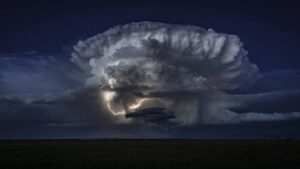American West’s gravity anomalies are a signpost to Storm copper riches

The gravity anomalies – including a large 2.3km anomaly below the 4100N zone – point to a large-scale copper system at Storm. Pic via Getty Images.
The potential of American West’s Storm Project to hold a large-scale sediment-hosted copper system has received a major boost from a recently completed high-resolution ground gravity survey.
The survey identified several strong gravity anomalies, including the large “Mother Lode” anomaly, below and adjacent to the known near-surface copper mineralisation.
American West Metals (ASX:AW1) notes that these extend for several kilometres and are interpreted to represent dense bodies that are consistent with copper sulphide deposits.
Evidence that at least one of these anomalies harbours copper mineralisation, comes from a 2022 drill hole that intersected its outer periphery and intersected 68m of copper-bearing sulphide mineralisation from 277m down-hole to the end of hole, indicating that mineralisation remains open at depth.
Additionally, the gravity anomalies are coincident with historical electromagnetic and induced polarisation anomalies.
Managing Director Dave O’Neill said that the data from the recent survey supports the company’s geological assumptions and the potential for a large copper system below the near-surface copper mineralisation.
“The high-resolution survey has successfully defined a series of large, dense bodies that sit directly under the high-grade 4100N Zone, and in key areas around the other known high-grade copper deposits,” he added.
“Importantly, our interpretation of the gravity data is supported by coincident historical geophysical anomalies and the 2022 discovery of copper sulphides in drill hole ST22-10, which is located on the edge of one of the newly identified gravity targets.
“The gravity anomalies are modelled to commence around 200m below surface and have a strike of several kilometres. We are chasing big copper targets here.”
Drill out continuing apace
O’Neill added that the resource drill-out of the near-surface copper is “progressing very well” and the company is confident of delivering a significant maiden copper resource at Storm from its results alone.
“The new copper targets at depth are a game-changer for the potential copper endowment at Storm and we are excited to prioritise drilling of these exciting targets for the 2023 field program,” said Dave.
Recent assays from drilling at the 4100N Zone are 29m at 1.1% copper from 59.4m including 9.2m at 2.2% copper from 71.6m (SR23-02) and 67.1m at 1.1% Cu from 54.9m including 4.6m at 2.6% copper from 64m and 9.1m at 2.5% copper from 79.3m (SR23-03).
Gravity survey results
The gravity survey is interpreted to have effectively defined a series of dense features that are spatially associated with the interpreted graben fault architecture and known copper sulphide mineralisation at Storm.
Notably, the geological features closely adhere to the typical sediment-hosted copper model as seen in the large copper deposits of central and southern Africa and highlight the exceptional exploration potential of the area.
These anomalies appear to have higher densities where they intersect the main graben faults and form a series of lobes with decreasing density away from the faults.
The ‘northern fault’ gravity anomaly, which is located north of the main fault, extends over about 4.8km and is broken into two main zones.
The easternmost zone is located directly below the 4100N Zone, where ongoing drilling has defined thick and continuous copper mineralisation in the near surface over 1km of strike
Meanwhile, the ‘southern fault’ gravity anomaly is approximately 4km long, lies south of the graben fault, and is bounded by the 3500N, 2750N and 2200N high-grade copper zones.
Adding further interest, a 3D inversion completed on the gravity data resulted in the identification of high priority drill targets, the largest of which is located along the northern fault and directly underneath the 4100N Zone.
This “Mother Lode” feature commences at about 200m depth and is about 2.3km long.
The gravity feature is intersected by a strong historical IP anomaly on its upper contact. This is a highly significant association and indicates a both dense and electrically chargeable body, which is intriguing as the only known dense and chargeable geological feature at depth within the Storm area are sulphides.
Looking ahead
American West’s drilling at the 4100N Zone will continue in the summer field program, with a focus on expansion of the mineralised footprint. This program will be followed by resource definition drilling at the 2200N and 2750N Zone.
Processing and interpretation of the MLEM data is almost complete and the company will schedule diamond drilling to test new high-priority exploration targets identified from the gravity survey.
Ore sorting and beneficiation test work for a potential direct shipping ore (DSO) operation is continuing with results to follow shortly while an environmental baseline survey will begin shortly.
This article was developed in collaboration with American West, a Stockhead advertiser at the time of publishing.
This article does not constitute financial product advice. You should consider obtaining independent advice before making any financial decisions.
Related Topics

UNLOCK INSIGHTS
Discover the untold stories of emerging ASX stocks.
Daily news and expert analysis, it's free to subscribe.
By proceeding, you confirm you understand that we handle personal information in accordance with our Privacy Policy.








